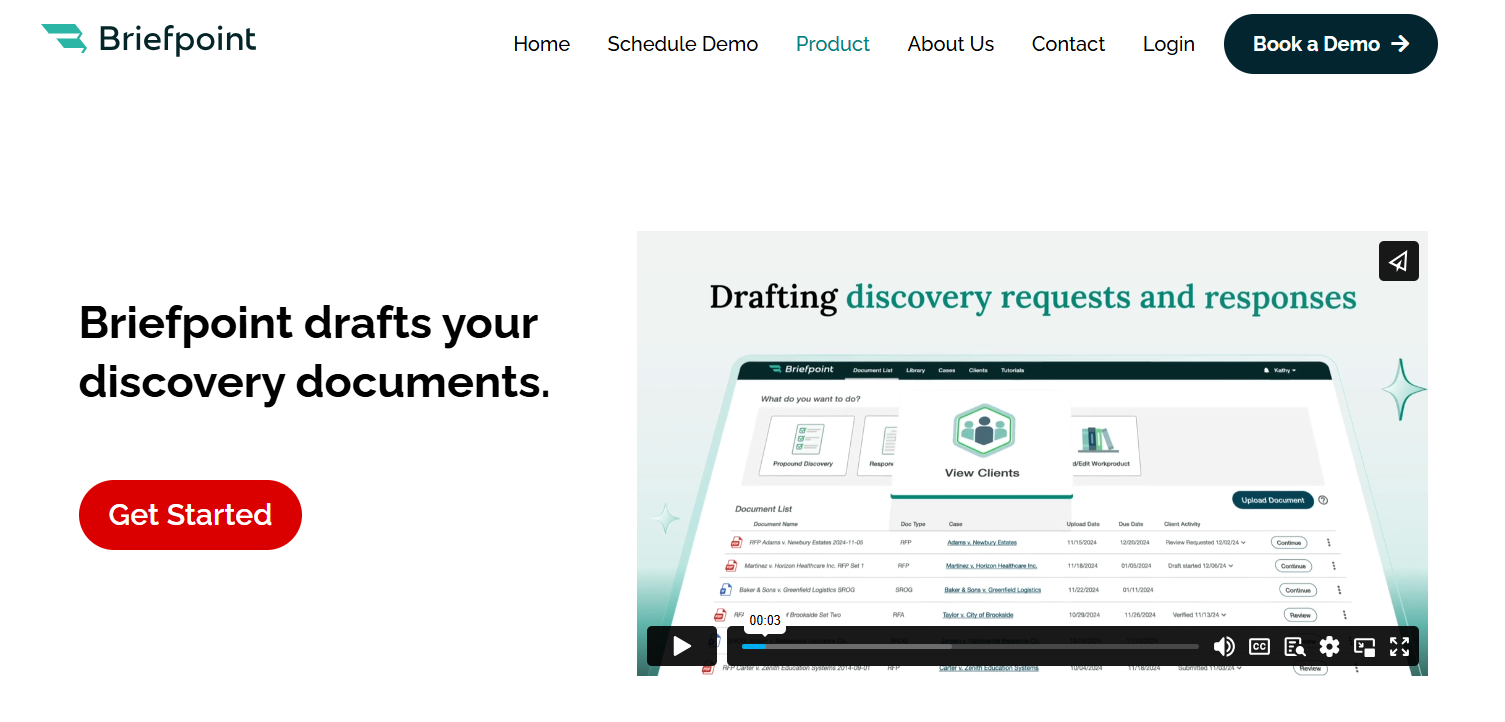Top 9 Clio Integrations to Simplify Your Legal Practice
Top 9 Clio Integrations to Simplify Your Legal Practice
At its core, an integration means two different software tools “talking” to each other. In Clio’s case, it means pulling in features from other platforms without bouncing between a million tabs.
The goal? Less clicking around, more getting things done.
Some integrations handle documents, some take care of billing, and others help you find information faster. And the best part is you don’t need to be a tech expert to use them.

Best Clio Integrations You Should Consider
Here’s a list of Clio integrations that can make a big difference in your day-to-day work. Let’s dig in.
1. Briefpoint
If you’re spending hours on discovery requests and responses, Briefpoint can seriously lighten your load. It’s one of the most helpful Clio integrations for law firms dealing with civil litigation, personal injury, or employment matters.

With Briefpoint, you can draft your discovery documents in minutes. Powered by artificial intelligence, it handles things like Requests for Admission, Requests for Production, and Interrogatories for every U.S. state and D.C.
But here’s what really makes it stand out: it talks to your clients in plain English. Briefpoint takes the legal jargon out of the process, so your clients can answer questions without getting confused.
Then, it takes those answers and drops them right into your response documents. No back-and-forth, no guessing.
Getting started is easy. There’s no setup or onboarding. Just sign in and go. Inside Clio, you’ll upload the opposing counsel’s request, add objections (which Briefpoint can help write), and let the tool collect responses from your client.
If you’re looking to save time and skip the hassle of drafting from scratch, Briefpoint is a great place to start. Give it a try today!
2. NetDocuments
NetDocuments is a smart choice if you want better control over your Clio documents. As part of a strong practice management software setup, it helps you organize everything in one secure place, which cuts down on time spent searching through messy folders.
It’s built for legal practice needs, making it easy to search, edit, and share documents without slowing down your day. Since it’s cloud-based, you can access your case files anytime, anywhere, whether you’re handling a court deadline or meeting prospective clients.
If document management has been a pain point for your firm, connecting NetDocuments with Clio can clean up your workflow fast and keep your legal practice running smoothly.
3. Casetext
Casetext, now known as CoCounsel, is a great Clio integration if you want to make legal research faster and less of a grind. It connects right to your Clio matter, so you can jump into search court records, statutes, and case law without switching tools.
You can run keyword searches across millions of digital documents and get results that actually match the legal issues you’re working on. It’s built to save you time and cut down on duplicative data entry. Plus, it lets you link your research directly to the case you’re handling.
If legal research is eating up too much of your day, Casetext can make it a whole lot simpler and a lot less frustrating.
4. DocuSign
DocuSign is one of the easiest ways to improve client relationships while cutting down on delays. Instead of waiting for clients to print, sign, and send back paperwork through postal mail, you can send everything electronically right from your Clio software.
It’s perfect for things like case initiation documents, engagement letters, and other forms you need signed fast. Plus, it’s a huge help during client onboarding, making the first steps simple and professional.
By adding DocuSign to your Clio setup, you can move past slow administrative processes and get your matters moving quicker. For example, instead of mailing out a retainer agreement and waiting a week, you can send it through DocuSign and have it back the same day.
5. Docket Alarm
Docket Alarm makes it easy to stay on top of court filings without all the manual checking. It connects directly to your Clio platform, so you can pull in important updates without missing a beat.
You can import data like case statuses, bankruptcy notices, and new filings straight into Clio Manage. It even helps with client intake by letting you know right away when there’s a completed proof of service or a major update tied to your client’s case.
For instance, instead of waiting for a court to mail a filing notice, Docket Alarm can send it straight to your dashboard, help you respond faster, and keep your cases moving.
6. Lawmatics
Lawmatics is a smart Clio integration if you want to make lead generation and client intake easier. It helps you bring in new clients by automating things like intake forms, follow-ups, and scheduling.
Everything is automatically synchronized with your Clio account, so once a lead becomes a client, their information is already in place. No extra typing, no missed details.
Lawmatics also integrates seamlessly with Clio Manage, so you can streamline operations across intake, marketing, and client communication. If you’re looking for a better way to keep new clients coming in without piling more admin work on your plate, Lawmatics is a great pick.
7. QuickBooks
When it comes to handling firm finances, QuickBooks doesn’t just make life easier; it makes client billing feel almost effortless. Instead of juggling spreadsheets or worrying about missed payments, you can connect QuickBooks to your Clio account and pull billing info straight from your existing matters.
You’ll keep accurate records without having to enter the same numbers twice. Everything lines up, which means fewer mistakes and less time fixing errors. That’s a big plus when you’re trying to build a stronger client experience and avoid billing headaches later.
QuickBooks is one of the best tools out there for lawyers who want to spend less time crunching numbers and more time focusing on their clients.
8. CaseMail
CaseMail is a great Clio integration if you’re tired of dealing with the hassle of certified mail. It lets you send documents electronically while still meeting compliance requirements, which means no more standing in line at the post office.
It’s built for legal work, so whether you’re filing something with the Supreme Court, an appellate court, or just serving documents in a regular case, CaseMail keeps everything official and trackable.
Plus, it stores the legal information you need alongside your Clio matters. It keeps the same facts organized without any extra busywork.
9. AgileLaw
AgileLaw is built to help you run depositions more efficiently, especially if you’re looking to cut down on the paper trail. It brings everything online—exhibits, annotations, and transcripts—so you’re not stuck shuffling documents around.
\What makes it stand out is the way you can build a custom action for each deposition. That means smoother workflows and fewer surprises during the process. It also drastically cuts the time you’d normally spend organizing and sharing exhibits.
If you’re already using Clio to manage your cases, Agile Law fits right in by keeping your deposition prep fast, simple, and completely digital.
Need A Great Clio Integration? Start With Briefpoint
If you’re new to Clio integrations and not sure where to begin, Briefpoint is a smart starting point. It’s fast, easy to use, and solves a problem every busy legal practice faces: drafting discovery documents.

And once you see how much smoother your workflow gets, you’ll start spotting other areas where integrations can help too, whether it’s managing documents, handling billing, or improving client intake.
So if you’re ready to make your legal practice more efficient without adding more steps, connect Briefpoint to your Clio account and see the difference for yourself.
FAQs About Clio Integrations
What are Clio integrations, and why should I use them?
Clio integrations let you connect Clio with other tools, like QuickBooks, DocuSign, or Briefpoint, to automate tasks and simplify your daily work. They help cut down on manual entry and keep everything in one place.
Can I use multiple integrations with Clio at the same time?
Yes, you can use several integrations together. In fact, combining tools like Briefpoint for discovery, DocuSign for signatures, and QuickBooks for billing can create a much smoother workflow across your whole firm, especially when it comes to streamlining billable work and cutting down on manual tasks.
Do I need technical skills to set up Clio integrations?
No. Most Clio integrations are plug-and-play. Many come with step-by-step setup guides, and some don’t even need any setup at all, like Briefpoint, which works right after you sign in.
Can Clio integrations help automate newsletters or email campaigns?
Yes. If you use tools like Caramail, which integrates with Clio, you can automate newsletters and email campaigns based on your client data.
The information provided on this website does not, and is not intended to, constitute legal advice; instead, all information, content, and materials available on this site are for general informational purposes only. Information on this website may not constitute the most up-to-date legal or other information.
This website contains links to other third-party websites. Such links are only for the convenience of the reader, user or browser. Readers of this website should contact their attorney to obtain advice with respect to any particular legal matter. No reader, user, or browser of this site should act or refrain from acting on the basis of information on this site without first seeking legal advice from counsel in the relevant jurisdiction. Only your individual attorney can provide assurances that the information contained herein – and your interpretation of it – is applicable or appropriate to your particular situation. Use of, and access to, this website or any of the links or resources contained within the site do not create an attorney-client relationship between the reader, user, or browser and website authors, contributors, contributing law firms, or committee members and their respective employers.
Top 5 Smokeball Integrations Law Firms Should Know
Top 5 Smokeball Integrations Law Firms Should Know
Tired of jumping between tools and redoing the same tasks in your practice? Smokeball integrations were built to fix that.
They help you connect the software you already use, cut down on repetitive work, and keep everything tied to your matters, without making things more complicated.
This guide covers the most helpful Smokeball integrations and how they actually work. From billing and emails to meetings and document drafting, these tools can help you stay organized, save time, and focus on what really needs your attention.

What Are Smokeball Integrations?
Smokeball integrations are simply other tools that connect with Smokeball so you can work faster and cleaner. Instead of hopping between platforms or redoing work, these integrations let everything sync, which helps you save time and build a more profitable, organized firm.
For example, you can:
- Send emails in Outlook and automatically save them to your Smokeball matters
- Push bills into QuickBooks without manual entry
- Connect templates and documents through Briefpoint
- Run Zoom meetings directly from your calendar
- Automate tasks with Zapier
These tools help you keep better track of your clients, fees, and leads while making sure your data stays in the right place.
Best Integrations For Smokeball
You don’t need every integration under the sun. But a handful of the right ones can really change how your day goes. We’ve compiled some of the most helpful Smokeball integrations to consider.
1. Briefpoint
Briefpoint is built for law firms that want to handle discovery faster without cutting corners. When paired with Smokeball, it lets you create key legal documents in minutes and automatically saves them to the correct matter folder—no setup or manual sorting needed.

Here’s what you can generate with Briefpoint:
- Requests for Admission
- Requests for Production
- Interrogatories
- Responses to all of the above
How it works:
- Upload the .pdf (like a complaint or discovery request)
- Choose your objections and add responses
- Download your draft in Word and finish it up
Briefpoint reads court names, case numbers, and request types from your upload and fills in the basics, following local formatting rules. You handle the legal substance while Briefpoint handles the busywork.
Smokeball users love Briefpoint because it saves serious time, reduces non-billable hours, and keeps everything organized automatically. You won’t need to juggle files or retype client info. It works across all 50 states and D.C., and it’s simple enough for any attorney to use.
With strong encryption and no data shared for training AI, it’s also a secure choice for firms that care about privacy.
Book your demo today and see how it works!
2. QuickBooks
QuickBooks is a solid pick for firms that want to keep their finances clean and up to date. When linked with Smokeball, it brings all your billing, expenses, and payments together without the usual hassle. Instead of jumping between tools, you can manage everything in one place.
Here’s why it’s worth connecting QuickBooks with Smokeball:
- Syncs client bills and payments with a single click
- Keeps expenses and financial data updated automatically
- Pulls in contact information from your matters
- Cuts down on manual entry with smart automation
- Helps you track what’s owed and what’s paid
- Makes tax time and reporting way easier
- Lets your team focus on legal work, not accounting
With this setup, you don’t have to second-guess what’s been billed or paid. Everything stays current, accurate, and easy to access.
3. Microsoft Outlook
Microsoft Outlook is one of the most useful integrations for Smokeball, especially if you’re already using it to manage your emails.
Once connected, it helps you stay organized by linking emails, attachments, and contact details directly to your Smokeball matters. This way, all your communication stays in one place, easy to find, and tied to the right client or case.
With Outlook and Smokeball, you can:
- Save emails and attachments to the right matter
- Sync client contact information
- Log sent and received messages automatically
- Keep communication clear, updated, and easy to review

4. Zoom
Zoom makes it easy to meet with clients or team members without skipping a beat. And when you connect Zoom with Smokeball, those meetings get even easier to manage. You can schedule Zoom calls straight from your Smokeball calendar, and everything stays linked to the right matter.
There’s no need to run between apps or worry about losing track of meeting info. With the Smokeball logo right there in your workflow, you’ll know your details are in the right place.
Key benefits of connecting Zoom with Smokeball:
- Schedule and launch calls from your Smokeball calendar
- Keep meeting links and notes tied to each matter
- Cut down on back-and-forth emails
- Stay focused when you need to run your day smoothly
5. Zapier
Zapier is a powerful tool that helps you connect Smokeball with thousands of other apps, from Gmail and Slack to Google Drive and beyond. It’s good for law firms that want to run a more profitable operation without adding more manual work to their plate.
You can build simple workflows, called “Zaps,” that move data between tools automatically. Once set up, you won’t have to think about it again.
Why use Zapier with Smokeball:
- Connect Smokeball with other popular tools
- Automate repetitive tasks and save time
- Keep everything you need in one place
- Focus on legal work while Zapier handles the rest
Make the Most Out of Smokeball, Connect Briefpoint Today
If you’re using Smokeball to stay organized and efficient, Briefpoint is the perfect next step. It takes the most time-consuming part of litigation—drafting discovery documents—and makes it fast, accurate, and stress-free.

With just a few clicks, you’ll have clean, formatted documents saved right to your Smokeball matters, ready to review or send.
This isn’t just about saving time. It’s about working smarter, cutting down non-billable hours, and focusing on the parts of your practice that really matter.
Ready to simplify your workflow and boost productivity? Learn more about Briefpoint today!
FAQs About Smokeball Integrations
Does Smokeball integrate with QuickBooks?
Yes, Smokeball integrates with QuickBooks Online. This connection helps sync invoices, payments, and expenses automatically, so you can keep your financial records updated without manual entry.
Does Smokeball integrate with Gmail?
Smokeball integrates directly with Microsoft Outlook, but you can still connect Gmail using tools like Zapier. This setup lets you automate email workflows and keep your communication organized.
Is Smokeball better than LEAP?
Both are solid legal practice management tools, but the right one depends on your firm’s needs. Smokeball focuses on productivity and built-in automation, while LEAP leans more into document management. Many small to mid-size firms prefer Smokeball for its simplicity and customer support.
The information provided on this website does not, and is not intended to, constitute legal advice; instead, all information, content, and materials available on this site are for general informational purposes only. Information on this website may not constitute the most up-to-date legal or other information.
This website contains links to other third-party websites. Such links are only for the convenience of the reader, user or browser. Readers of this website should contact their attorney to obtain advice with respect to any particular legal matter. No reader, user, or browser of this site should act or refrain from acting on the basis of information on this site without first seeking legal advice from counsel in the relevant jurisdiction. Only your individual attorney can provide assurances that the information contained herein – and your interpretation of it – is applicable or appropriate to your particular situation. Use of, and access to, this website or any of the links or resources contained within the site do not create an attorney-client relationship between the reader, user, or browser and website authors, contributors, contributing law firms, or committee members and their respective employers.